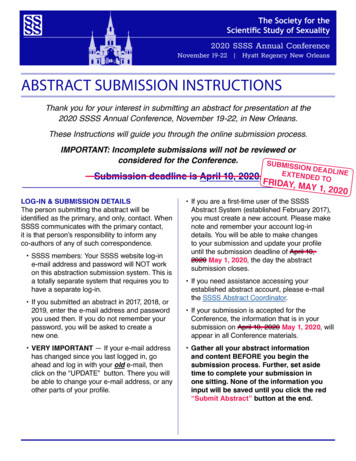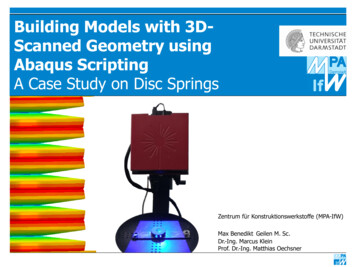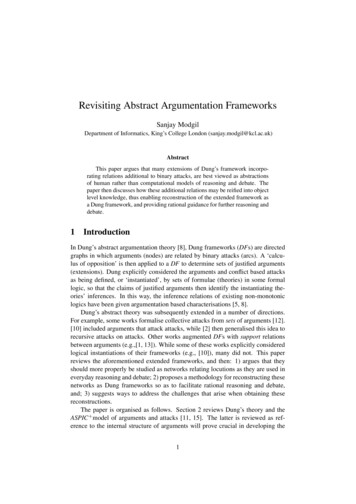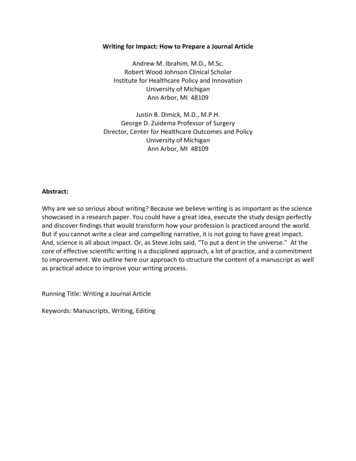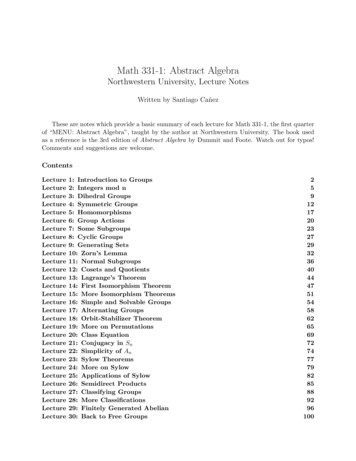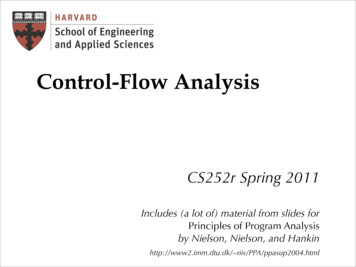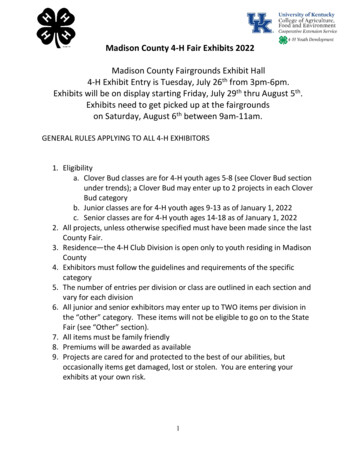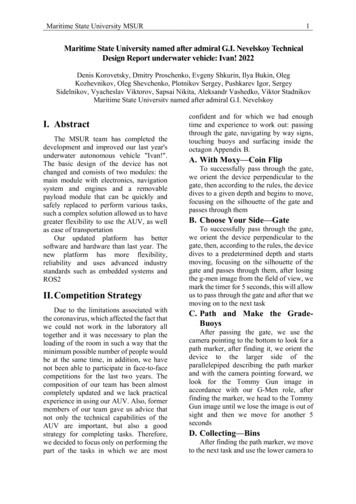
Transcription
Maritime State University MSUR1Maritime State University named after admiral G.I. Nevelskoy TechnicalDesign Report underwater vehicle: Ivan! 2022Denis Korovetsky, Dmitry Proschenko, Evgeny Shkurin, Ilya Bukin, OlegKozhevnikov, Oleg Shevchenko, Plotnikov Sergey, Pushkarev Igor, SergeySidelnikov, Vyacheslav Viktorov, Sapsai Nikita, Aleksandr Vashedko, Viktor StadnikovMaritime State Universitv named after admiral G.I. NevelskoyI. AbstractThe MSUR team has completed thedevelopment and improved our last year'sunderwater autonomous vehicle "Ivan!".The basic design of the device has notchanged and consists of two modules: themain module with electronics, navigationsystem and engines and a removablepayload module that can be quickly andsafely replaced to perform various tasks,such a complex solution allowed us to havegreater flexibility to use the AUV, as wellas ease of transportationOur updated platform has bettersoftware and hardware than last year. Thenew platform has more flexibility,reliability and uses advanced industrystandards such as embedded systems andROS2II. Competition StrategyDue to the limitations associated withthe coronavirus, which affected the fact thatwe could not work in the laboratory alltogether and it was necessary to plan theloading of the room in such a way that theminimum possible number of people wouldbe at the same time, in addition, we havenot been able to participate in face-to-facecompetitions for the last two years. Thecomposition of our team has been almostcompletely updated and we lack practicalexperience in using our AUV. Also, formermembers of our team gave us advice thatnot only the technical capabilities of theAUV are important, but also a goodstrategy for completing tasks. Therefore,we decided to focus only on performing thepart of the tasks in which we are mostconfident and for which we had enoughtime and experience to work out: passingthrough the gate, navigating by way signs,touching buoys and surfacing inside theoctagon Appendix B.A. With Moxy—Coin FlipTo successfully pass through the gate,we orient the device perpendicular to thegate, then according to the rules, the devicedives to a given depth and begins to move,focusing on the silhouette of the gate andpasses through themB. Choose Your Side—GateTo successfully pass through the gate,we orient the device perpendicular to thegate, then, according to the rules, the devicedives to a predetermined depth and startsmoving, focusing on the silhouette of thegate and passes through them, after losingthe g-men image from the field of view, wemark the timer for 5 seconds, this will allowus to pass through the gate and after that wemoving on to the next taskC. Path and Make the GradeBuoysAfter passing the gate, we use thecamera pointing to the bottom to look for apath marker, after finding it, we orient thedevice to the larger side of theparallelepiped describing the path markerand with the camera pointing forward, welook for the Tommy Gun image inaccordance with our G-Men role, afterfinding the marker, we head to the TommyGun image until we lose the image is out ofsight and then we move for another 5secondsD. Collecting—BinsAfter finding the path marker, we moveto the next task and use the lower camera to
Maritime State University MSURlook for images in order to orient the deviceand reset the marker using the marker resetdevice, which was presented in detail lastyearE. SurvivetheTorpedoesShootout—After passing the buoy, we look for thedirection vector to the buoy closest to us,focusing on the signal power, after findingthe vector, we start moving and look for theBootlegger marker in parallel, after findingit, we approach to such an extent that themarker occupies 80% of the frame height,after that we aim at a larger distance andmake a shot, after finishing the shot weagain we are looking for an acousticbeacon, but now a remote one2A. General constructionFor the device, a bulb for electronicswas made of AlMg5 aluminum Figure 1with a thickness of 4 mm, acrylic with athickness of 10 mm was chosen for the lid,the cracker adheres to the body through aflange sealed with a round rubber band, wechecked the hermiticity of the body using avacuum pump. For reliable operation of thedevice, an analysis of the strength of thecase was carried out, which showedsufficient rigidity of the body of thedeviceFigure 2F. Cash or Smash—OctagonStarting to move to the lighthouse, weset A To a depth of 1 meter and look for abottle marker, after detecting the marker,we center and float to the surface in theoctagonIII. Design CreativityThere is a clear division in our team intothe following roles: designer, programmerof upper and lower level, electronicsengineer. The student takes a roledepending on the competencies he has.Students are guided by mentors who controlthe process of building the AUV, giveadvice on any questions that a student mayhave, and take part in the coordination ofthe entire project.Figure 1 "Improved housing with electronics"Figure 2 “Structural stress analysis”B. Torpedo launcherThe torpedo launcher, shown in Figure3, is a construction consisting of a plastictube with a torpedo inside of it, capacity ofcompressed air and solenoid valve whichwas installed between them. The solenoidvalve is locked and keeps excessivepressure in the capacity before launch.When potential difference (voltage) isapplied, it is opened and the airimmediately with great speed goes throughthe tube, and simultaneously pushes thetorpedo. An important element of thedevice is a tube, the length of which waschosen empirically taking into account theinitial torpedo rate and its accuracy. Alsothe team paid much attention to thedevelopment and creation of the torpedo.Correct form and proper ballasting of itallowed to achieve the required results.Before each start it is necessary to makepumping and recharge device. The teamuses 2 torpedoes launchers. The weight of
Maritime State University MSUReach of them is 0.8 kg, the shooting distanceis 3 m. Figure 3 Render of torpedo launcher.Figure 3 "Render of torpedo launcher"IV. Electrical systemA. BatteryWe replaced the lithium polymerbatteries Figure 4 with more high-currentlithium ion batteries, as we found problemsin the fact that under some operating modesof the AUV battery, the batteries weselected lacked current transfer, nothing haschanged in the mechanism of disconnectingthe device, it is also a magnetic switch3orientation sensing. It makes it possible todetermine roll, pitch, magnetic heading,and rate of angular motion of the vehicle.Magneticheadingissubjecttointerferences generated by thrusters andelectronic systems. In order to reduce theirimpact, the team did the best to locateinertial system as far from the interferencesources as possible and placed it on aseparate housing on top of the vehicle2. Depth sensorTo determine the depth, we use theMS5803-30BA sensor already available onthe AUV, which has the followingcharacteristics: Measurement range: 0 to 30bar Measurement accuracy: 0.2mbar3. Hydroacoustic systemAs planned, we replaced thehydroacoustic antennas with Russian RT1.332820-1 antennas, this allowed us toincrease reliability and no longer be afraidto damage the antennas, in addition, wereplaced the motor controllers to get rid ofinterference, since the motor control PWMwas on the same frequency as ahydroacoustic beacon Figure 6Figure 4 "New battery"Figure 6 "Validating acoustic interference"Figure 5 "Battery pack and Ethernet switch"B. Sensors1. Orientation sensorsThe vehicle is equipped with IMU andthe depth sensor. The team uses 9 AxisAHRS HWT905. It is a complete inertialsystem that includes a triaxial gyroscope, atriaxialaccelerometer,triaxialmagnetometer, pressure sensor, and anextended Kalman filter (EKF) for dynamic4. CameraWe replaced expensive industrial IDScameras with hobby VEYE-MIPI-327sFigure 9, these cameras have a goodphotosensitive sensor with a good dynamicrange, even greater than the previous ones,and are connected via the MIPI interface,which made it possible to get rid of delaysand an expensive gigabit switch in the case,in addition to this these cameras are morecompact and consume less power, so wehave reduced the body of the camerasFigure 7
Maritime State University MSURFigure 7 "Reduce camera case"C. CommunicationFor data transfer and connection ofperipheral devices, the following interfacesare used: Ethernet, USB, RS-232, 1-Wire,i2c. Devices with high bandwidth areconnected to Ethernet (main computer,navigation controller). In the remote controlmode, communication with the ground isalso through Ethernet. As an ethernetswitch, we use mikrotik RB952Ui-5ac2nDFigure 54Taskswith"high"computingrequirements are performed on an onboardcomputer based on Nvidia Jetson NX, withan ubuntu operating system and a ros2system, we redesigned the system and tookorca3 [1] as a basis and adapted it to ourneeds, we wrote [2] a low-level driver forcommunicatingwithanavigationcomputer.The main method of object detection isthe use of convolutional neural networks.According to the test results, the SingleShot Detector MobileNet V2 demonstratesthe best ratio of accuracy and performance.This neural network is based on Inceptionarchitecture.Figure 8 "AUV Network"V. SoftwareAll AUV software can be classified intohighlevel and low-level software. The lowlevel software runs on the STM32F407based onboard controller board, under theFreeRTOS real-time operating system.Here low-load computational tasks thatrequire real time are implemented: calculating course, roll/depth,speed, and depth controls; sending commands to the thrusters; control of executive devices andsome sensors; performing emergency proceduresFigure 9 "Nvidia jetson NX and Camera"Also, traditional recognition algorithmsare used for object detection such as colorthresholding and contour analysis.VI. Experimental resultsWe have successfully tested the deviceboth in the aquarium Figure 11 and in thepool Figure 10, thanks to the tests in theaquarium, we were able to verify the
Maritime State University MSUR5train, train the neural network, and export itto the format we need, if necessary, we canalways retrain our neural network Figure 12Figure 10 "Tests in pool"Figure 12 "Classification result"VII. AcknowledgmentsFigure 11 "Tests in aquarium"tightness of the new case. to adjust the PIDregulators, further tests in the basinconfirmed that the body is hermitic at greatdepth and the regulators work as needed.this gave us valuable operational data thatallowed us to improve the design of thedevice, the main difficulty for us were thelimitations associated with COVID, but wesuccessfully overcame them since ourentire team was successfully vaccinatedand we strictly monitored the number ofpeople working in the laboratory and forthis year, we did not have a single case ofinfection.We also trained a neural network todetect badge using the edgeimpulse service[3], thanks to this service we can easilymark up our dataset, specify the necessarymarkers, divide the sample into test andWe are grateful to the universityadministration for administrative, technicaland moral support. We would like to thankThe Center for Robotics Development forthe help in purchasing the equipment. Weare thankful to N. N. Andreyev AcousticsInstitute for providing an acoustic pinger.We would like to thank NationalTechnology Initiative MARINET forfinancial support.
Maritime State University MSUR6Appendix A: Component kerT200Motor nitVisionTekkoNvidiaF4Jetson NXWitMotion10Ah ost(if new)Max thrust:5.1 kg f Maxpower:350Watts50A100 8G ROM, 256 1500 SSD16,8 volts 4sMIPIIMX327SUC&NL RT1.332820-150 OpenCV 3,SingleShotDetectorMobileNet V2FFT,triangulationKalman nd mappingAlgorithms:autonomyOpen sourcesoftwareTeamSize(numberofpeopleTesting tedby member,behavior treeOpenCV,ROS2, Orca313100 hoursC,C ,PythonStatusnewnewnew
Maritime State University MSURAppendix B: Mission state machine7
Maritime State University MSUR8Appendix С: Outreach ActivitiesOur team members and mentors helped organize the 7th All-Russian Underwater RoboticsCompetition, which was hosted by MSU on May 7-8, 2022. [4]Figure 13 "Conducting 8 All-Russian competitions in underwater robotics"Student members of our team conducted master classes for schoolchildren on underwaterrobotics. They introduced schoolchildren to the types, construction, and potential of underwatervehicles. The schoolchildren got practical experience in piloting the ROV.Figure 14 "Сonducting a master class for schoolchildren"We actively participate in scientific conferences on marine robotics. We make reportspopularizing our developments.
Maritime State University MSURFigure 15 «Russia Day, holiday June 13»9Figure 16 «Russia Day, holiday June 13»We actively participate in the popularization of underwater robotics among the population,we participate in city holidays and an exhibition, for example, on the day of Russia on June 13,we presented a pool on the city square where anyone could control our AUV from the remotecontrol
Maritime State University MSUR10References[1][2][3][4]"Orca3," [Online]. Available: https://github.com/clydemcqueen/orca3."msur," [Online]. Available: https://github.com/Photon94/msur.[Online]. Available: https://studio.edgeimpulse.com/.[Online]. Available: https://robocenter.org/news/346.
After passing the buoy, we look for the direction vector to the buoy closest to us, focusing on the signal power, after finding the vector, we start moving and look for the Bootlegger marker in parallel, after finding it, we approach to such an extent that the marker occupies 80% of the frame height, after that we aim at a larger distance and



